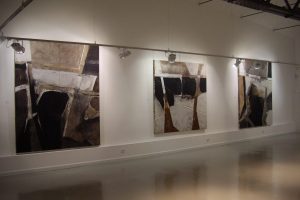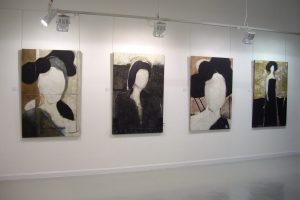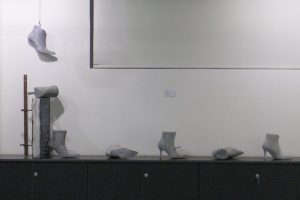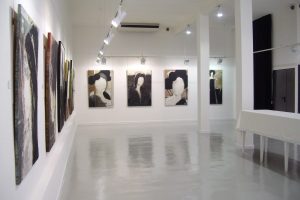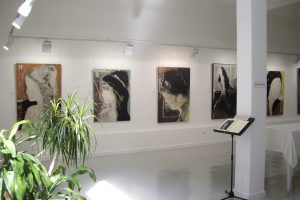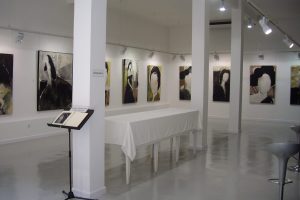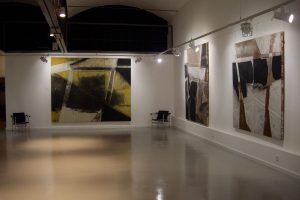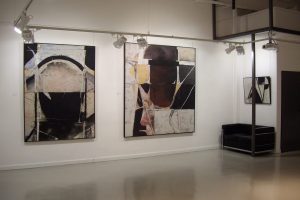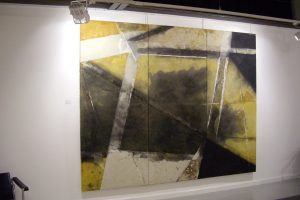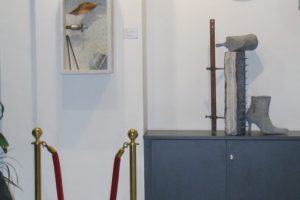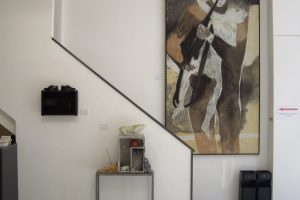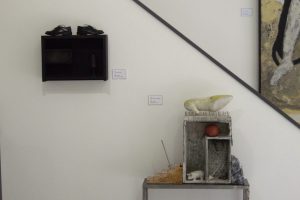
‘ALFREDO BIKONDOA: PORTRAITS OF A PHILOSOPHY’ AT THE JEAN PAUL PERRIER FINE ART GALLERY IN BARCELONA
03/11/10 to 04/30/10
Abstraction and figuration at the Jean Paul Perrier Fine Art in Barcelona. The exhibition mainly collects the recent figurative series ‘Ten thousands goddesses’ by Bikondoa.
‘A portrait of nothingness’, by Alfonso de la Torre (fragments)
Painting a portrait is not so much adding as laying bare. It is the proposal of a journey to the depths of the conscience, rather than an Entertainment derived in the ornate nature of the surface of things.
This is how it is understood by Alfredo Bikondoa (Donostia), whose particular gallery of portraits of nothingness in this exhibition held at the Jean Paul Perrier Art Gallery eliminate, on principle, the totality of the signs which appear traditionally consubstantial to the face: eyes, mouth or nose, scarcely an expression. Facing up to, and never better said, a melancholy journey to the countenance, be it one’s own face or that of another following a most contemporary trajectory which is not free of entropy and which demonstrates that process of disintegration which, almost fatally, is supposed by perception. True knowledge, that which the sharp intelligence distils, supposes, in the end, the arrival at the limit which approaches, in irreparable aporia, a kind of not knowing of the conscience and which then becomes, in this way, an essential element of trae painting. For Bikondoa, ‘to see’ supposes distancing oneself from the object, and ‘painting the portrait’, before anything, implies the obviation of the skin of things, creating a tension which frequents our creative time, that is, the result of a blind dialogue which anchors its root in the wellknown debate between identity and otherness. (…)
With this as his starting point, noble in its nihilism, Bikondoa, in tackling his peculiar vision of corporeal representation, obviates the deceptive fullness of the signs of the skin, leaving behind, after the difficulty of the creative struggle, the slightest surface trace of mineral evocation as a quasiinescapable condition of the portrait. With something of the music of the skin of the faces of Giotto. A portrait reduced in this way to a kind of fossilized and silent polygon, a space which in the first place reveals absence, without avoiding ‘looking’ straight ahead. Perhaps, the portrait is on occasions delimited by the hair, this being conceived of as the “perfect diadem” of which Valéry, Monsieur Teste to be precise, sang in his “Le Cimitière Marin”. (…)
The eyes in Bikondoa’s portraits are obviated, and yet they ‘look’ boldly upon the spectator; this artist proposes the cegazón of a portrait sterling among the shadows: it would appear to have been conceived of on a dimlylit stage, removed from the “deceitful colours” which had been negated as well by the poet of Sète. And the result is a dazzling, immaterial face, of an indelible purity, from a pristine brush that speaks more of logos than of imago. The face thus converted into pure light: a transfiguration rather than a representation. (…)
As did Bacon, Bikondoa also makes use of sfumatto to present some of his portraits, which seemed to be bathed in a blind oriental light which is so precious, arriving at the point, at times –as occurs in one of the 2009 works from the series “Ten Thousand Goddesses” (“Diez mil diosas”), of disappearing. A face converted in a watery sea of colour, of hues navigating in the support. Or, at times, his faces are pierced by the presence of lines which speak of an old yearning for cubismo and signography, both memories, perhaps, of his Parisian times. The suggestion for cubism is evident, for example, in the very beautiful and quite terrifying “The Lotus in the Marsh” (“El loto en la ciénaga”) (2008), while in the case of signography, we recommend contemplating his moving “Diez mil diosas” (20052009) series, an essential Collection which comprises a good part of the portraits exhibited now at the Jean Paul Perrier Art Gallery.
There, in a work from the same series, his portrait’s face reveals a slender thread of blue light, which appears to recall the modiglianesque paintings of light blue panniers. Here, others reveal, almost, the white surface of the face, the other skin to which the painter accustoms himself in the solitude of the silent subsoil of his studio in Donostia (San Sebastian). The whiteness and emptiness of the pictorial support which thus contains it is wellknownthe possibility of nothingness. A journey from white to white, from support to the nothingness of nothingness. As in life. White, like the sheet of fabric that will swaddle the first skin of the newborn and later become a shroud. Speaking, in the end, of the end which we know awaits the face. The expression, we are reminded by the sculptor of twisted bodies, Hans Bellmer, is a displaced pain, and the face, as conceived by Bikondoa, acquires, by virtue of its muteness, its most precise essence. (…)
The obsession of an artist who searched for, unfound, the portrait of a face. Portraying himself with a tremulous truth, thus, on the way.

